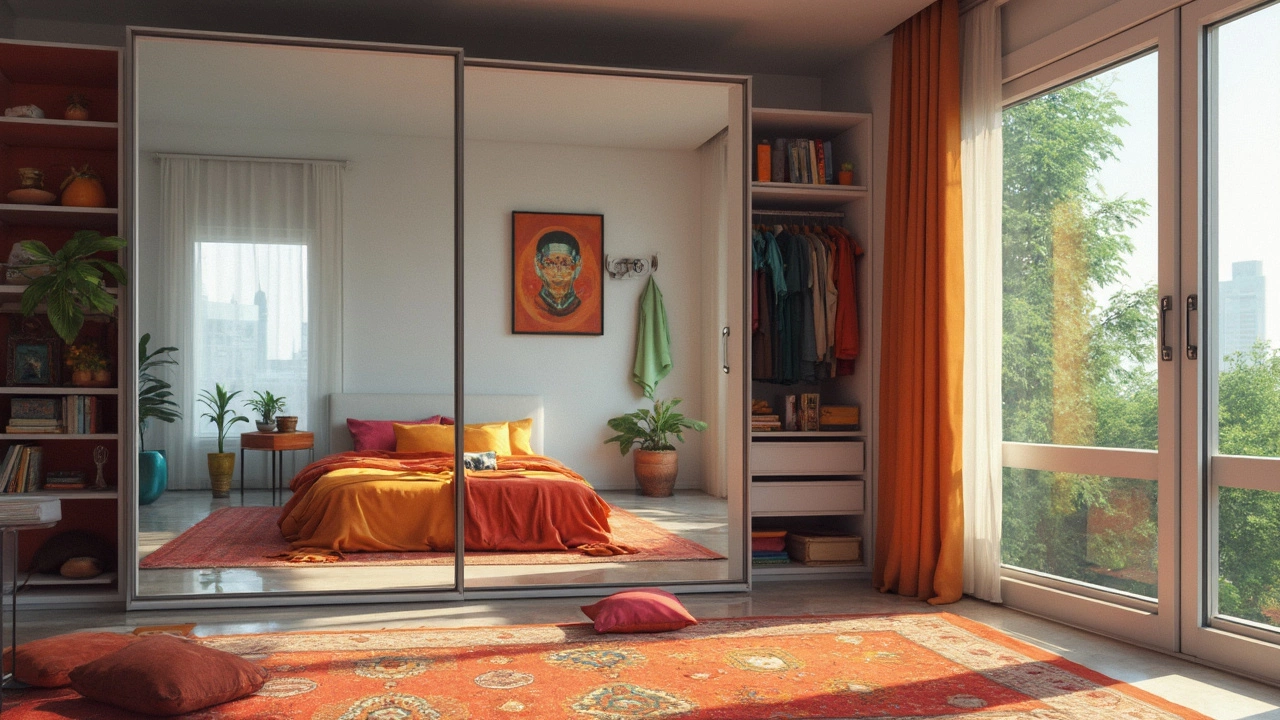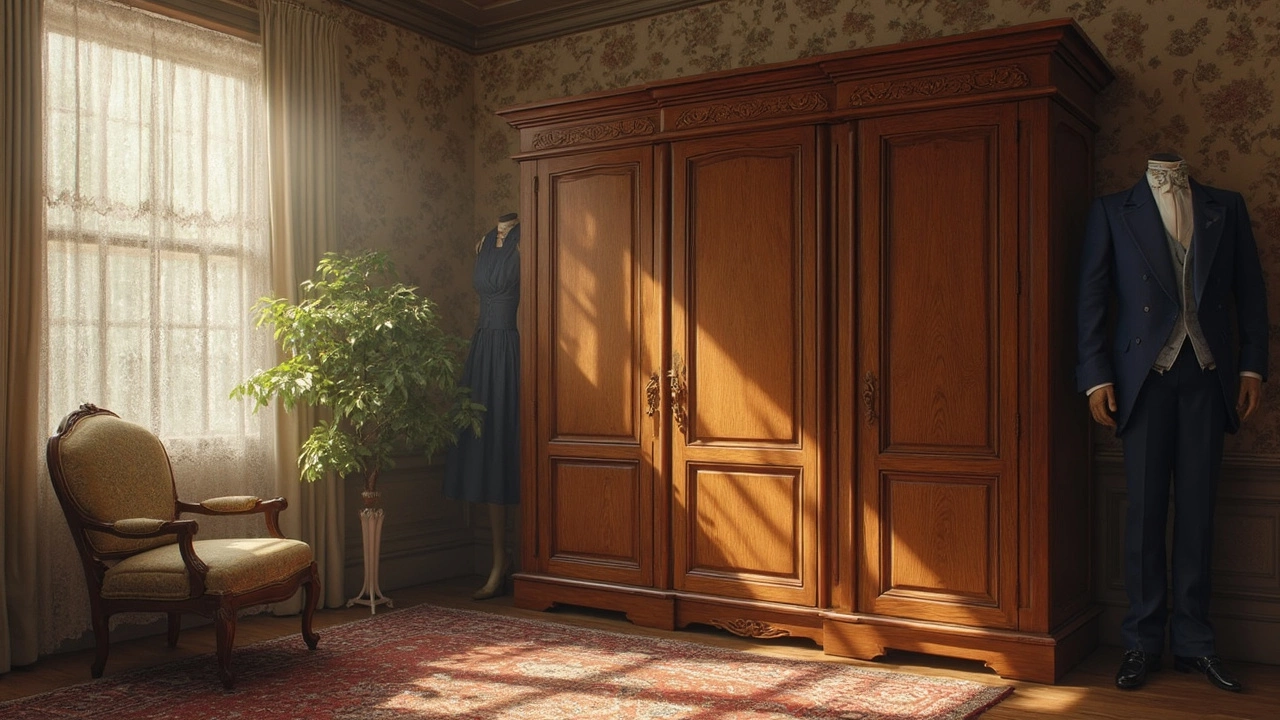You ever hear someone in the U.S. talk about their closet and wonder what happened to the wardrobe? Well, in America, folks typically use the word 'closet' instead of 'wardrobe.' It might sound like splitting hairs, but it's got a lot to do with how homes are built and lived in over here.
Back in the day, American homes started including built-in spaces in rooms specifically for clothes storage, which naturally got dubbed 'closets.' So if you're browsing furniture stores or real estate listings, knowing these terms can save you a heap of confusion. Stick around, and we’ll dig into why this word swap happened and share some cool tips for making the most of your storage space.
- Wardrobe vs. Closet: The Basics
- Why 'Closet' in America?
- History of Home Designs
- Different Types of Closets
- Space-Saving Tips
- Choosing the Right Storage Solution
Wardrobe vs. Closet: The Basics
Alright, let's clear up the difference between a wardrobe and a closet because it can be a bit puzzling, especially if you're not from around here. In many parts of the world, a wardrobe is a standalone piece of furniture. Picture a big, tall cabinet with doors that open to reveal hanging space, shelves, maybe even a drawer or two. It's pretty much your go-to for storing clothes if you lack wall-space for building something in.
But in the good old U.S. of A, we've got closets built right into our homes. These are little rooms or alcoves with hanging rods and shelves, usually hidden behind sliding or hinged doors. Closets are all about convenience and maximizing space without getting an extra piece of furniture. And they're not just for clothes either—linen closets, broom closets, you name it, there's a closet for it.
Why the difference? Well, it's a mix of architectural trends and lifestyle habits. In post-war America, homes were designed with efficiency in mind. So, building storage into the architecture itself made a lot of sense. Why buy a separate wardrobe when you can just use that built-in space?
To give you an idea of how common these are, about 70% of American homes have a closet in every bedroom. That might not sound like a big deal, but when you're touring a house or apartment here, you definitely want to check out those closet spaces. It can flip your decision from 'meh' to 'sold.'
- Wardrobe: Standalone furniture, often ornate, used for clothes
- Closet: Built-in storage space, potentially multi-purpose
So if you're moving to the States or just curious about how people stash their stuff, knowing the lingo helps. Whether you're team wardrobe or team closet, it's all about keeping things neat and handy.
Why 'Closet' in America?
Ever wonder why folks in the U.S. keep calling it a closet instead of a wardrobe? Well, let's break it down. In the States, when homes started sprouting in the 19th and 20th centuries, builders began including small, dedicated spaces for clothes in bedrooms. This design was a bit different from older European homes, where people used standalone wardrobes, which were like a piece of furniture you could move around.
The word 'closet' itself has roots in the Latin word 'clausum,' which means 'closed place.' Makes sense when you think about it. These built-in storage spaces were closed off from the rest of the room, unlike the more open concept of a wardrobe. With the rise of consumerism and a shifting lifestyle, people found it efficient to have a tidy little spot built straight into the wall to hold their stuff. Over time, it just became the norm to say 'closet.'
Another interesting tidbit is that in American homes, the closet isn't just for clothes. Many use them as a catch-all storage spot for everything from board games to cleaning supplies. The versatility makes the closet indispensable in modern American home design.
Here's a fun fact: Some studies suggest that the average American home has about 6.8 closets. So next time you're in a house over here, don't be surprised to find these hidden gems everywhere you look.
History of Home Designs
Alright, let's step back in time a bit and see how we ended up with closets instead of wardrobes in American homes. Way back in the 17th and 18th centuries, most houses, even the fanciest ones, didn't come with built-in storage. People used furniture pieces like armoires and wardrobes to store their clothes.
But then things changed in the 19th century. As American architecture evolved, especially with the rise of more urban living, built-in storage started popping up. This was partly due to space-saving concerns and the convenience factor. Instead of having massive furniture pieces taking up floor space, folks loved the idea of dedicated storage spaces built right into the walls.
Fast forward to the mid-20th century, built-in closets became the norm in new American homes. Builders saw it as a selling point. Who doesn't love more floor space? By then, the term 'closet' had become synonymous with any kind of built-in storage space.
Interestingly, the French influence in early American architecture can't be overlooked, as the word 'closet' itself has roots in France, where it was used to describe small rooms or enclosed spaces. So, this term stuck around as homes got more streamlined and functional in design.
Fun fact: By the 1950s, the average American home had multiple closets, and it was pretty much unheard of to build a new house without them. This set it apart from homes in Europe, where the standalone wardrobe furniture remained popular for quite a while longer.

Different Types of Closets
When it comes to closets in America, there's more than just one style in the neighborhood. Closets come in various shapes and sizes, tailor-made to fit whatever storage needs you've got.
First up, we've got the walk-in closet. This one’s usually the dream for many, giving you space to move around, organize, and choose your outfit without feeling cramped. They're often found in master bedrooms and can be a real lifesaver if you're dealing with a large wardrobe.
Then there's the reach-in closet. These are more commonplace and often found in kids' rooms or smaller spaces. They’re usually shallow, fitted with a single rod and a shelf, making it super simple for organizing everyday clothes.
If you've got tighter spaces, a linen closet might pop up. These are typically in hallways or bathrooms, and they're perfect for storing towels, bedsheets, and other linens. Think of them as the utility player of the closet world.
Don’t overlook the utility of a pantry closet. These are essential in kitchens, helping with food storage, home appliances, and even cleaning supplies. With some organization skills, a pantry can make meal prep a breeze.
For those who like having everything in its place, custom closets might be the way to go. These can be designed down to the last detail, with specialized racks, shelves, and compartments.
Here's a quick breakdown to keep things straight:
- Walk-in Closet: Spacious, found in master bedrooms.
- Reach-in Closet: More compact, typical for small rooms.
- Linen Closet: Stores linens, often in bathrooms or hallways.
- Pantry Closet: Essential for kitchen storage.
- Custom Closet: Tailored to your specific needs.
Whether you're planning a renovation or just trying to organize your stuff, knowing these types of closets helps you make the best call!
Space-Saving Tips
Feeling cramped in your closet? You're not alone. Maximizing space is a universal struggle, but there's plenty you can do to make your closet work harder for you. First off, embrace the vertical. Those walls aren't just there to hold up pictures; you can use them to stack storage!
- Double-Hang Clothing Rods: Adding a second hanging rod below the first one can instantly provide more space for shirts, blouses, or folded pants. This simple trick effectively doubles your hanging space.
- Shoe Racks: Instead of letting shoes pile up on the floor, use a shoe rack or over-the-door shoe organizer. It's amazing how much space you save when shoes have a proper home.
- Use Clear Storage Bins: Transparent bins let you see what you've stored without having to rummage. Try to label them too, so you know which bin holds what at a glance.
Getting creative with how you use the space is key. Have you ever thought about going seasonal with your wardrobe? You can store off-season clothes in those high-up hard-to-reach spots until you need them again.
Also, consider using a mix of shelving and hanging solutions. Adjustable shelving can fit your needs as they change. Pop in a few handy baskets. They're great for holding smaller items or even linens.
And don't underestimate the space below. Storage bins or baskets beneath hanging clothes make the most out of every inch and keep things tidy.
Taking a few steps to reorganize can make your space feel so much bigger—and it’s way cheaper than adding an extension to your home. Tackle one tip at a time, and soon enough, your closet will be a master class in efficiency!
Choosing the Right Storage Solution
Picking the perfect place to stash your stuff can feel like a puzzle, especially with all the options out there. But don’t worry, we’ve got you covered. First off, think about what you’re planning to store. Clothes, shoes, or those random knick-knacks that never find a home? Knowing what you need to hide away will guide you in the right direction.
For many folks, a built-in closet is a dream because it’s super customizable. You can add shelves, hangers, and drawers to fit everything just right. Got a smaller space? Consider a freestanding wardrobe. These can squeeze into tighter spots, and some even come with mirrors on the doors! Handy, right?
If you’re short on space, vertical storage can be a game changer. Use tall shelving units or stackable boxes on top of one another to make the most of those often ignored heights. And if you’ve got kids or roommates, keeping everything organized with labelled bins or baskets can help keep the peace.
- Maximize Space: Use ceiling-high shelves or clothes racks.
- Dual Purpose Furniture: A bed with storage drawers is a lifesaver in small spaces.
- Transparent Bins: See everything without opening them, saving precious time.
- Adjustable Shelving: Move shelves up and down to accommodate your changing needs—perfect for growing collections!
Lastly, remember that organizing isn’t just about cramming things into a wardrobe or closet. It’s also about making sure everything is easy to find, so you’re not late searching for that shoe’s elusive partner or last winter’s coat.
